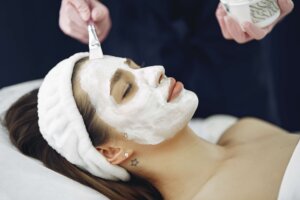The Path to Clearer Skin

Skin discoloration is a common concern that many individuals face. Whether it’s dark spots, uneven skin tone, or patches of hyperpigmentation, these conditions can affect one’s self-esteem and confidence. However, understanding the causes, types, and available treatment options for skin discoloration is the first step towards achieving a more even and radiant complexion. In this beauty blog, we will delve into the world of skin discoloration, shedding light on its underlying causes, discussing various types, and exploring effective treatment options to help you achieve a clearer, more uniform skin tone.
Causes of Skin Discoloration
Skin discoloration can arise from various factors, including:
- Hyperpigmentation: Excessive production of melanin, the pigment responsible for skin color, can lead to dark spots or patches on the skin. Sun exposure, hormonal changes, and certain skin conditions can trigger hyperpigmentation.
- Post-Inflammatory Hyperpigmentation: After inflammation or injury to the skin, such as acne, cuts, or burns, melanin production can increase, resulting in dark spots that linger even after the initial issue has healed.
- Melasma: This condition causes symmetrical patches of brown or grayish pigmentation on the face. Hormonal changes, pregnancy, and sun exposure often contribute to the development of melasma.
- Vitiligo: Vitiligo is a condition where the skin loses pigmentation, resulting in white patches. It occurs due to the destruction of melanocytes, the cells responsible for producing melanin.
Treatment Options for Skin Discoloration
Thankfully, several treatment options are available to address skin discoloration:
- Topical Treatments: Over-the-counter and prescription creams containing ingredients such as hydroquinone, retinoids, kojic acid, or azelaic acid can help reduce hyperpigmentation and even out the skin tone.
- Chemical Peels: These procedures involve the application of a chemical solution to exfoliate the top layers of the skin, revealing a fresher, more evenly toned complexion.
- Laser Therapy: Laser treatments, such as intense pulsed light (IPL) or fractional laser resurfacing, can target and break down pigmented cells, stimulating the production of new, healthier skin cells.
- Microdermabrasion: This non-invasive procedure involves exfoliating the skin using tiny crystals or a diamond-tipped wand, helping to improve the appearance of uneven skin tone and texture.
- Camouflage Makeup: Cosmetics specifically designed to conceal skin discoloration can provide temporary coverage and help even out the skin tone.

Prevention and Skincare Tips
In addition to treatment options, incorporating preventive measures and a proper skincare routine can help manage skin discoloration:
- Sun Protection: Regularly apply a broad-spectrum sunscreen with at least SPF 30 to shield the skin from harmful UV rays, which can worsen hyperpigmentation and melasma.
- Gentle Cleansing: Use a mild cleanser suitable for your skin type to cleanse the face, avoiding harsh scrubs or products that may irritate the skin.
- Moisturization: Hydrate the skin with a moisturizer appropriate for your skin type to maintain its barrier function and promote overall skin health.
- Avoid Picking or Scratching: Refrain from picking at blemishes or scratching the skin, as this can lead to post-inflammatory hyperpigmentation.
- Seek Professional Advice: If you are concerned about skin discoloration, it’s best to consult with a dermatologist or skincare professional who can provide personalized guidance and recommend the most suitable treatment options for your specific condition.
In conclusion, understanding the causes, types, and available treatment options for skin discoloration is crucial in addressing and managing this common concern. By incorporating effective treatment methods, preventive measures, and a consistent skincare routine, you can achieve a clearer, more even complexion and regain your confidence in your skin’s appearance. Remember, embracing your skin’s natural beauty is a journey, and with the right knowledge and approach, you can navigate the path to a more radiant and uniform skin tone.



